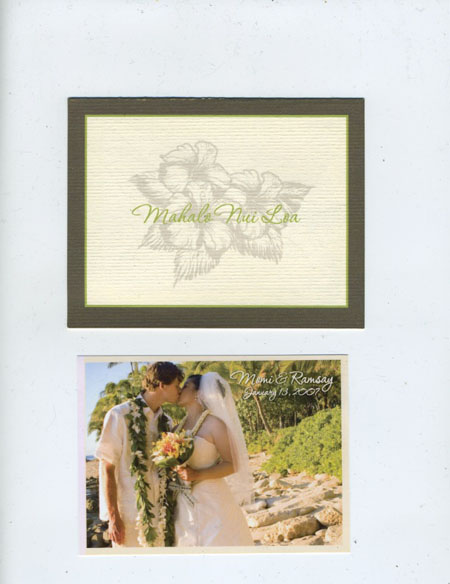![]() body | color | collections | commodity | cube | document | fabric | fetish | gender | glass | home | identity | living | machine | metal | minimal | mobility | narrative | olfactory | organic |
body | color | collections | commodity | cube | document | fabric | fetish | gender | glass | home | identity | living | machine | metal | minimal | mobility | narrative | olfactory | organic |
![]() pain | paper | plastic | plugs | power | protective | rectangular | ritual | round | sound | souvenir | spiritual | style | text-based | time | tool | touch | uniform | value | visual | warm | wood
pain | paper | plastic | plugs | power | protective | rectangular | ritual | round | sound | souvenir | spiritual | style | text-based | time | tool | touch | uniform | value | visual | warm | wood
| Wedding Card and Photograph | |||
Narrative: This wedding card and photograph, as well as a previously discarded envelope, were mailed from Hawaii to New York City through the US Postal Service. They are from my good friends Ramsay and Momi Barnes. They were stored in a box of special correspondence, and scanned in July 2013 before the physical documents were added to a bundle sculpture. The photograph's journey was complex. Layered paper is produced by putting a number of sheets of paper in a stack and gluing them together. Using a photographic process a negative of the image is exposed to a flat plate and coated with a light sensitive material. The plate is developed, and the image area is coated with an oily material that will attract ink but repel water. The non-image area is coated. One plate per color is created. The plate is passed under a roller on the printing press, which coats it with water. The image area on the plate, previously treated with the oily material, repels the water and remains uncoated. An ink roller is next passed over the plate. A rubber roller is then passed over the printing plate and the ink from the plate is transferred to it. The card paper is passed under the rubber roller and the ink is transferred to it. This is done in color order. The ink dries before it enters the next roller assembly. This process of wetting, inking, and printing is continuous throughout the card manufacturing run. After both sides of the pasteboards are printed, they are transported to a card cutting station. Precision-cutting machines cut the cards out from the printed sheets. Digital C-prints are the result of printing a digital file on a continuous tone printer that uses silver-based paper. The photograph is created by exposing the paper with light sources (such as lasers or LEDs) and then processing the exposed paper with traditional chemistry. The most common papers are type-C papers processed in RA-4 chemistry. The continuous tone printers include the Lightjet, Durst Lambda, and the Chromira, and labs that make these types of prints will usually advertise that they use one of those three brands.
|
 |
||
![]()
